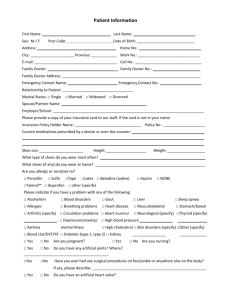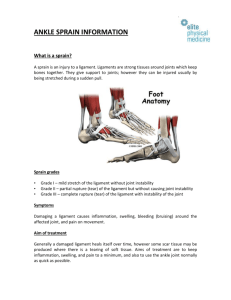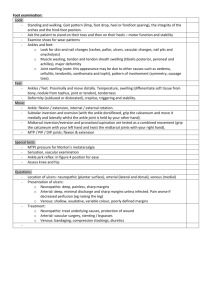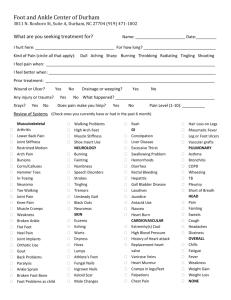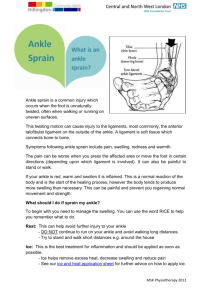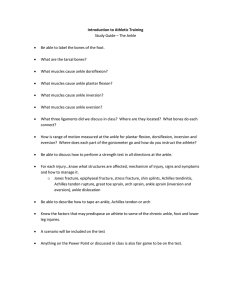Ankle sprain advice Instructions for patients Oxford University Hospitals
advertisement
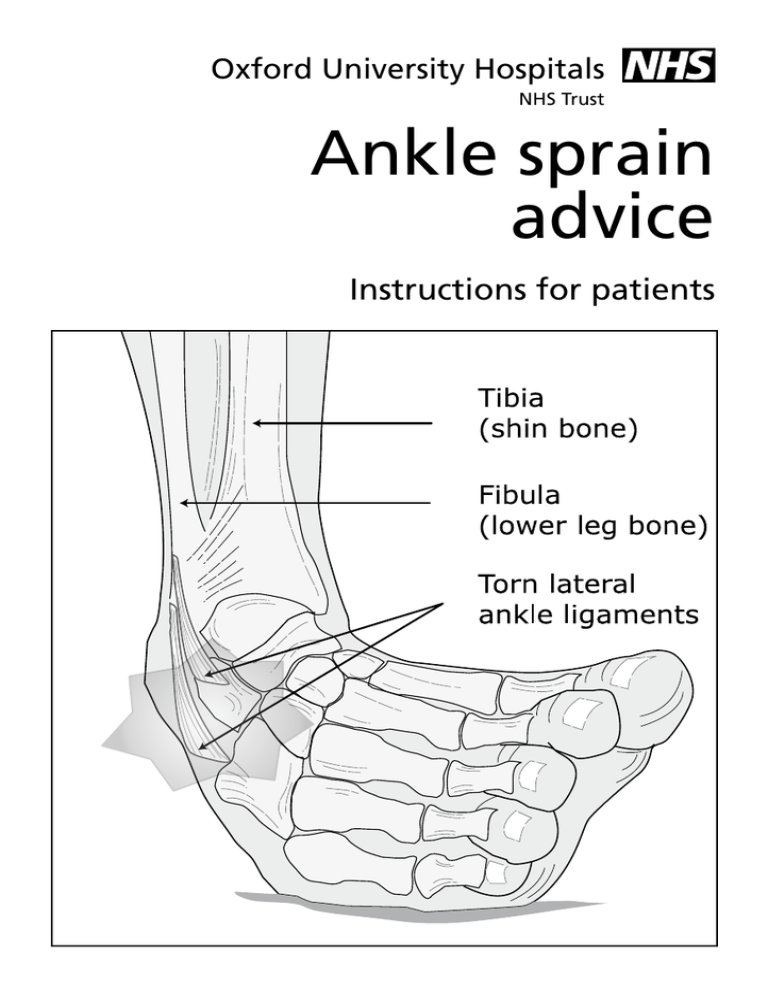
Oxford University Hospitals NHS Trust Ankle sprain advice Instructions for patients What is an ankle sprain? An ankle sprain is a common injury, often caused when the ankle is forced to bend more than normal. This stretches and weakens the ligaments and soft tissues that hold the ankle and foot bones in place. What are the symptoms? • mild ache to sudden pain •swelling •bruising • inability to move the ankle normally. How is it treated? The first treatment is to calm the inflammation and control the swelling and pain. This can be managed with the ‘RIPE’ treatment (Rest, Ice, Painkillers, Elevation). Early weight bearing (putting weight on your injured foot) has been shown to help sprained ankles to heal more quickly. This is why most people with an acute ankle sprain will not be given crutches. Always try to walk normally, with your heel striking the floor first, then rocking forward on your foot and pushing off with your toes. page 2 R Rest: Rest will help prevent further injury and allow the healing process to begin. For the first few days, reduce the amount of walking you do and gently exercise your ankle regularly to avoid stiffness. Avoid forceful and strenuous activity, such as running and jumping, until you can walk without it causing any pain. I Ice: Ice can help reduce swelling and reduce pain. Make an ice pack by wrapping a small bag of frozen peas (which you can re-use several times by re-freezing, but please do not eat them after doing this) or some crushed ice cubes in a damp towel. Put the ice pack on your injured ankle for 10 minutes every 2 hours, for the first couple of days after the injury. Then use the ice pack 3 times a day until the swelling goes down. P Painkillers: It is important that you take regular painkillers, to reduce the pain and help you keep moving around. Paracetamol and ibuprofen are effective painkillers if they are taken regularly. They can be taken at the same time. We do not routinely prescribe or dispense these painkillers, as they can be cheaply purchased over the counter at chemists and most supermarkets. Please read the instructions on the packets carefully for the correct dose to take and reasons why you might not be able to take these medications. E Elevation: Keeping your injured ankle raised above the level of your hips for the first few days after injury. This helps to decrease the swelling and pain. We no longer offer compression bandages for sprains, because they appear to have no beneficial effect on how quickly or fully you recover. Some people do find them comforting to use on sprained limbs and they can be purchased from most pharmacies if you wish to try them. page 3 Rehabilitation and recovery Healing of the ligaments normally takes about six weeks, although everyone recovers from injuries at different rates. Healing time is related how severe your injury is and any other medical problems that you might have. As healing gets underway, it is important that you begin a series of exercises, to help you get back the full use of your ankle by improving its flexibility and strength. This will help to reduce the risk of further sprains. page 4 Exercises At first your ankle will feel stiff and possibly painful. This is because it has been held in one position. By exercising regularly the feeling of stiffness and pain will gradually ease. The following exercises need to be done regularly; 3-4 times per day. Dorsiflexion and plantarflexion Pull your foot upwards as far as you are able, hold for 5 seconds, and then point your foot away from you as far as you are able, hold for 5 seconds. Repeat ___times. Inversion and eversion Turn the sole of your foot inwards and then outwards (keeping your knee still). Repeat___times. page 5 Assisted exercises Use a towel or something which does not stretch to assist with dorsiflexion, inversion and eversion exercises. Ankle slides Sit on a chair with your feet flat on the floor. Slide your injured foot backwards along the floor, keeping your foot flat on the floor throughout. Repeat___times. Toe crunching Sit on a chair and place a towel on the floor. Put your injured foot on the towel and, using your toes, ‘bunch’ the towel up and pull it towards you. Repeat___times. page 6 Seated heel raises Sit in a chair with both feet flat on the floor. Raise your heels up off the floor then lower them back down slowly Repeat___times. It will be safe for you to return to your normal activities when you have: • full strength • full range of movement • can use your ankle without pain or causing any swelling. If you have persistent problems with pain, swelling, you are not able to use your ankle properly, or your ankle is not recovering at the rate you expect, please see your GP. page 7 How to contact us If you have any questions or concerns, please contact: Minor side Emergency Department John Radcliffe Hospital, Oxford Tel: (01865) 220 224 Emergency Department Horton General Hospital Tel: 01295 229 415 Alternatively, you can contact your GP or NHS 111 (dial 111 (freephone) from any landline or mobile). If you have a specific requirement, need an interpreter, a document in Easy Read, another language, large print, Braille or audio version, please call 01865 221 473 or email PALSJR@ouh.nhs.uk Author: Emergency Nurse Practitioner Team, Physiotherapy Team August 2015 Review: August 2018 Oxford University Hospitals NHS Trust Oxford OX3 9DU www.ouh.nhs.uk/information OMI 12384P


